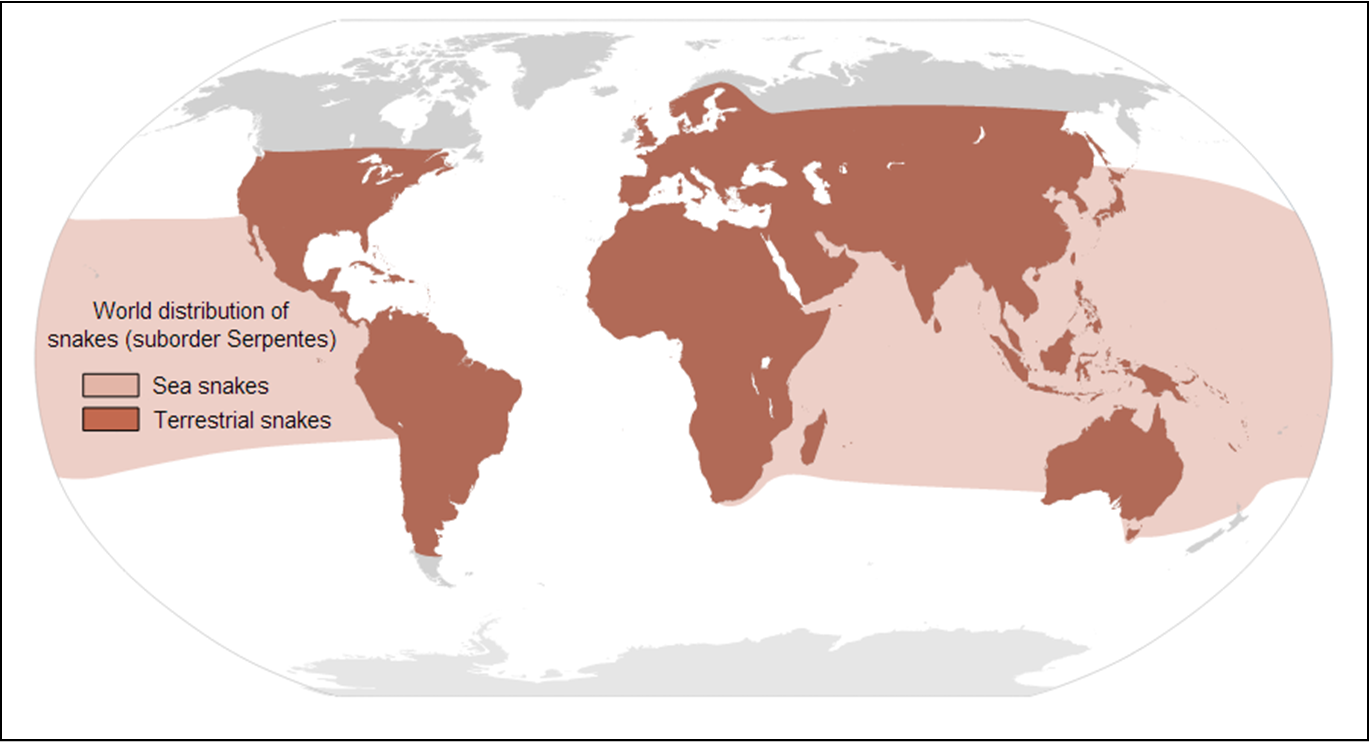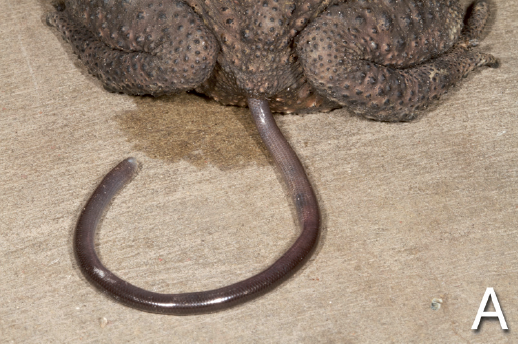 |
| Global distribution of snakes |
 |
| Map of locations of Brahminy Blindsnakes Modified from DiscoverLife and Kraus's database Most dots represent introduced localities |
How did this species evolve? The leading theory for most unisexual species of reptiles, amphibians, and fishes involves a hybrid origin, where two or more "parent" species contribute genes. In most unisexual amphibians and fishes, sperm from a male (often of one of the parent species, but sometimes any sperm will do) is required to initiate development of the eggs but does not contribute genetic material. This is not the case for lizards or for the Brahminy Blindsnake, which are truly parthenogenetic. Which were the parent species of the Brahminy Blindsnake? We don't know. Of the 400-odd blindsnake species, the Brahminy Blindsnake is probably one of the best known due to its wide distribution and peculiar reproductive habits. Some recent phylogenies have shown that it is closely related to the South Indian Blindsnake (Typhlops pammeces), and others to an undescribed species of Sri Lankan blindsnake, both consistent with the hypothesis that south Asia is the species' center of origin. One very recent analysis suggested reclassifying all three species into a new genus, Indotyphlops. Because up to a quarter of all blindsnake species are still undescribed, it's possible that the parent species are as-yet unknown to science.
 |
| Image from O'Shea et al 2013 You guessed it, that's a Brahminy Blindsnake |
Most of the time, an introduced species has about a 50/50 chance of successfully establishing itself in a new environment. Given how widespread Brahminy Blindsnakes are and their infamy as invaders, you might ask whether an introduced population of Brahminy Blindsnakes has ever failed to become established? A comprehensive database of reptile introductions includes only two such instances, one in southern Arizona and one in New Zealand. In Arizona, a population has subsequently become established despite the arid climate, but New Zealand is probably too cold for blindsnakes, and they take introduced species very seriously there. Nevertheless, the Brahminy Blindsnake will probably continue to spread, at least throughout the tropical regions of the world. The literature is full of first reports of this species, so much so that at least one was reported twice! Amazingly, both specimens were bicycle casualties collected in the same suburb of Cairo, leading the second author to title his article "How many times can a flower-pot snake be run over for the first time?"
Click here to read more about blindsnakes and their unique relationship with certain owls, or here for a refresher on their place in snake taxonomy!
ACKNOWLEDGMENTS
Thanks to Todd Pierson for his photograph and to Phil Rosen, Jeff Servoss, Don Swann, Michael Lau, and Skip Lazell for bringing me up to date on the latest in blindsnake biology.
REFERENCES
Baha el Din, S. M. 2001. On the first report of Ramphotyphlops braminus from Egypt: how many times can a flower-pot snake be run over for the first time? Herpetological Review 32:11.
Hedges, S., A. Marion, K. Lipp, J. Marin, and N. Vidal. 2014. A taxonomic framework for typhlopid snakes from the Caribbean and other regions (Reptilia, Squamata). Caribbean Herpetology 49:1-61 <link>
Kamosawa, M. and H. Ota. 1996. Reproductive biology of the brahminy blind snake (Ramphotyphlops braminus) from the Ryukyu archipelago, Japan. Journal of Herpetology 30:9-14.
Kraus, F. 2009. Alien reptiles and amphibians: a scientific compendium and analysis series. Springer, Dordrecht <link>
Nussbaum, R. A. 1980. The brahminy blind snake (Ramphotyphlops braminus) in the Seychelles Archipelago: distribution, variation, and further evidence for parthenogenesis. Herpetologica 36:215-221 <link>
O'Shea, M., A. Kathriner, S. Mecke, C. Sanchez, and H. Kaiser. 2013. ‘Fantastic Voyage’: a live blindsnake (Ramphotyphlops braminus) journeys through the gastrointestinal system of a toad (Duttaphrynus melanostictus). Herpetology Notes 6:467-470 <link>
Ota, H., T. Hikida, M. Matsui, A. Mori, and A. H. Wynn. 1991. Morphological variation, karyotype and reproduction of the parthenogenetic blind snake, Ramphotyphlops braminus, from the insular region of East Asia and Saipan. Amphibia-Reptilia 12:181-193.
Wynn, A. H., C. J. Cole, and A. L. Gardner. 1987. Apparent triploidy in the unisexual brahminy blind snake, Ramphotyphlops braminus. American Museum Novitates 2868:1-7 <link>
Life is Short, but Snakes are Long by Andrew M. Durso is licensed under a Creative Commons Attribution-NonCommercial-NoDerivs 3.0 Unported License.

